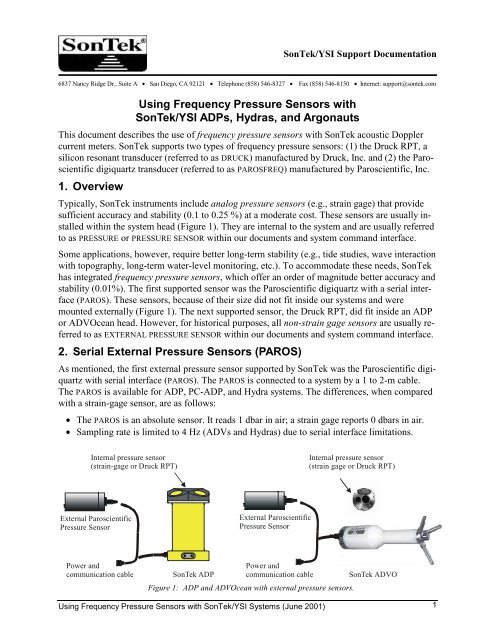SonTek/YSI Argonaut-XR Technical Manual - HydroScientific West
SonTek/YSI Argonaut-XR Technical Manual - HydroScientific West
SonTek/YSI Argonaut-XR Technical Manual - HydroScientific West
You also want an ePaper? Increase the reach of your titles
YUMPU automatically turns print PDFs into web optimized ePapers that Google loves.
Using Frequency Pressure Sensors with <strong>SonTek</strong>/<strong>YSI</strong> Systems (June 2001)<br />
<strong>SonTek</strong>/<strong>YSI</strong> Support Documentation<br />
6837 Nancy Ridge Dr., Suite A • San Diego, CA 92121 • Telephone (858) 546-8327 • Fax (858) 546-8150 • Internet: support@sontek.com<br />
Using Frequency Pressure Sensors with<br />
<strong>SonTek</strong>/<strong>YSI</strong> ADPs, Hydras, and <strong>Argonaut</strong>s<br />
This document describes the use of frequency pressure sensors with <strong>SonTek</strong> acoustic Doppler<br />
current meters. <strong>SonTek</strong> supports two types of frequency pressure sensors: (1) the Druck RPT, a<br />
silicon resonant transducer (referred to as DRUCK) manufactured by Druck, Inc. and (2) the Paroscientific<br />
digiquartz transducer (referred to as PAROSFREQ) manufactured by Paroscientific, Inc.<br />
1. Overview<br />
Typically, <strong>SonTek</strong> instruments include analog pressure sensors (e.g., strain gage) that provide<br />
sufficient accuracy and stability (0.1 to 0.25 %) at a moderate cost. These sensors are usually installed<br />
within the system head (Figure 1). They are internal to the system and are usually referred<br />
to as PRESSURE or PRESSURE SENSOR within our documents and system command interface.<br />
Some applications, however, require better long-term stability (e.g., tide studies, wave interaction<br />
with topography, long-term water-level monitoring, etc.). To accommodate these needs, <strong>SonTek</strong><br />
has integrated frequency pressure sensors, which offer an order of magnitude better accuracy and<br />
stability (0.01%). The first supported sensor was the Paroscientific digiquartz with a serial interface<br />
(PAROS). These sensors, because of their size did not fit inside our systems and were<br />
mounted externally (Figure 1). The next supported sensor, the Druck RPT, did fit inside an ADP<br />
or ADVOcean head. However, for historical purposes, all non-strain gage sensors are usually referred<br />
to as EXTERNAL PRESSURE SENSOR within our documents and system command interface.<br />
2. Serial External Pressure Sensors (PAROS)<br />
As mentioned, the first external pressure sensor supported by <strong>SonTek</strong> was the Paroscientific digiquartz<br />
with serial interface (PAROS). The PAROS is connected to a system by a 1 to 2-m cable.<br />
The PAROS is available for ADP, PC-ADP, and Hydra systems. The differences, when compared<br />
with a strain-gage sensor, are as follows:<br />
• The PAROS is an absolute sensor. It reads 1 dbar in air; a strain gage reports 0 dbars in air.<br />
• Sampling rate is limited to 4 Hz (ADVs and Hydras) due to serial interface limitations.<br />
Internal pressure sensor<br />
(strain-gage or Druck RPT)<br />
External Paroscientific<br />
Pressure Sensor<br />
Power and<br />
communication cable<br />
External Paroscientific<br />
Pressure Sensor<br />
Internal pressure sensor<br />
(strain gage or Druck RPT)<br />
<strong>SonTek</strong> ADP<br />
Power and<br />
communication cable <strong>SonTek</strong> ADVO<br />
Figure 1: ADP and ADVOcean with external pressure sensors.<br />
1


